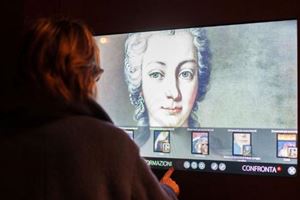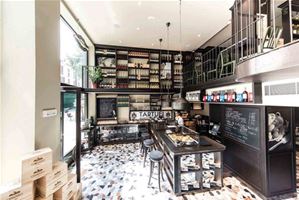When I walked into Felice
Limosani’s office overlooking Piazza Duomo on a brisk November afternoon, I had
the impression that this would not be your ordinary interview. Entering the
beautiful palazzo on via Roma and the office just above the Luisa Via Roma
store, where Limosani is creative director, I felt a wave of anxiety because,
quite honestly, I still could not grasp exactly what it is Limosani does for a
living. Creative director, trendsetter, concept designer, digital storyteller,
brand manager, multimedia artist, innovator-these are among the many buzzwords
used to describe Limosani and his work. After
an hour-long conversation and demos of his work, I started to get it: he
engages the sense, probes emotion, tells stories and communicates ‘concepts’
and corporate values through multimedia art installations. He is pioneering new
forms of corporate branding to engage the twenty-first-century consumer.
I’d like to start the interview with complete honesty
and admit that, after much research, I still don’t understand what your job is.
Would you mind describing what it is that you do?
[Laughing]
So many people ask me this question, and all I can say is the most important
thing is how I do what I do, and not
what I do per se. Being unable to describe my profession means that I do very
new things; if I could describe them, they wouldn’t be that new, would they? [Smiling] In short, and with much irony,
I think the best way to understand my profession is to stop trying to
understand it!
Your work is so varied. You combine many skills and abilities and
apply them to several forms of media. Can we say you are an innovator, just to
give your work a name?
Innovation
is in the air and I am just an interpreter of things and ideas that already
exist. Some say I am this and some say I am that, but, again, the important
thing is that I do high-quality work. I use my instinct and try to tune into to
the contemporary and take things from there.
I am also involved in a project with a
sociologist from Milan, Francesco Morace. I hold workshops on how to develop
global trends in aesthetics, consumption, communication and distribution in the
‘Third Renaissance’.
What’s the ‘Third Renaissance’?
We are in a period of great changes that
I believe is sort of a ‘Third Renaissance’ where communication and eventually
everything else happens from the bottom up. Today, information originates from
ordinary people who then consume it.
It is a very different reality from the past. Traditional forms of
communication and marketing were created when information was only one way, but
today they are inadequate. We need to understand these changes and start
inventing tomorrow, not continue to re-invent yesterday.
What’s your professional vision in light of these changes in course?
I think
consumption needs to be re-thought primarily because the concept of endless
growth is no longer sustainable. We need to start thinking in terms of
horizontal growth, not vertical growth, and the world needs to become more
competitive, humble, and collaborative. In the end, this is something the
Renaissance did.
Tell me how you communicate a brand or product.
I flirt with branding and art at the same
time. I don’t produce anything except my video or digital installations that
are based on a concept or a certain value that exemplifies the product or
company I work for. It’s an act of transfer: I transfer the values of the
company to the consumer by creating an emotional relationship between the brand
and its public. I create this relationship through art and creativity.
Then, if the product is valid, it will sell,
and if it doesn’t sell, it’s not my concern. My concern is to communicate a
product, not sell products. My work is aimed at a concept or feature that
evokes a product; it is not based on the product itself. It seems all very elusive and intangible,
but the companies I work for have understood this concept.
There is also an important emotional component to your work.
In my installations, the product becomes a story to tell, an emotional
experience, something that will be difficult to forget. Today, products are so banal; they enter and exit our minds almost
automatically. We don’t consume in traditional ways anymore, we are becoming
more sophisticated and refined-branding needs to be less obvious and more
sublime. Another important concept is interaction. Today, people want to be
involved in things. Every business sector needs to understand this and
encourage the need for interaction.
How did you start working in concept design and branding?
My training is rather unusual because I
started working in music. I worked as a DJ for over 20 years. I often hold
lectures for masters programs in Milan and Rome, and I tell students that a
master for me is not a degree from America but the device on a mixer that
harmonizes all the channels. Thanks to my background, I have a different
viewpoint than the standard academic one, but the final result is the same:
balancing out the volumes, the skills, the abilities, the sensibilities and
different kinds of knowledge. It’s all a matter of harmony, equilibrium and
knowledge.
Do you create your installations strictly for the purposes of art,
or do corporate sponsors commission them all?
No, all
my work has been commissioned by the corporate sector because I don’t have a
gallery owner to support and sustain me. Sometimes the installations are so
well liked that they become artworks, as did my Alfa Romeo video installation
that is now at the Sketch Gallery in London.
What other projects are in the works here
in Florence, aside from Luisa Via Roma?
Nothing, really! I live in Florence because I have my clothes here
and because I am in love here, but professionally, I work everywhere else other
than here. Jobs in Florence have been rather sporadic, like the installation I
did for the 60th anniversary of Pucci, but that happens every 60 years! I have
completed important projects for Luisa Via Roma; I followed its evolution, I
designed its interior, website and new ‘look’ or visual image. I am usually
involved in Pitti Uomo.
What do you think of Florence on a personal level?
I love
Florence as a city. I love the food, the cityscape and the surrounding
countryside. Professionally, however, Florence does not offer much in terms of
contemporary art or creativity. I know there are contemporary artists in the
city, but they are not visible, so it’s like they are not even here at all.
Let’s say I make Florence work for me. Thanks to my job, I can do a lot of work
online, and that helps. It helps me dream that when I am older, I will be
tanned on a beach and perhaps work from my computer.
Felice
Limosani, 42, began his professional career as a DJ. He
mixed tracks in discos all over Europe until 2000, when he began designing the
first emoticon services for UMTS-equipped mobile telephones. As a DJ producer,
he released LIMOS-The Night (Goes On),
released in 2001 by Universal-Sony Music; it was a European hit and the first
example of ‘emotional house.’ As an artist, he has created installations for
UNESCO, the Sketch Gallery (London), Ta Matete (Rome and Milan), Tempio di
Adriano (Rome) and the Ravello Festival. His video and digital works are on display
at the Tate Modern, Centre Pompidou and Palais de Tokyo. He is creative
director at Luisa Via Roma (Florence) and works for companies like Lacoste,
Nokia, Emilio Pucci, Bulgari, Puma, L’Oréal, FIAT, Ferretti Yacht, Tod’s and
Swarovski. Limosani’s work is based on the idea of combining creative
expressivity and contemporary art with communication and marketing. See some of
his work at www.felicelimosani.com.







